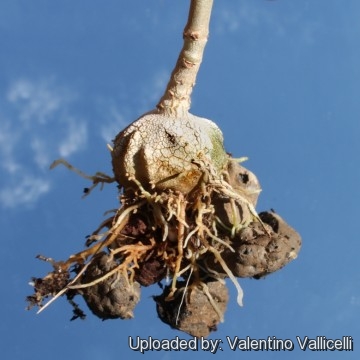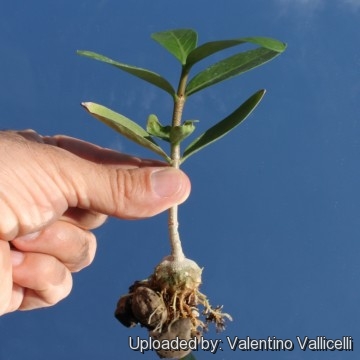
Hydnophytum formicarum Photo by: Valentino Vallicelli
Origin and Habitat: Sumatra, Malesia, Philippines
Synonyms:
See all synonyms of Hydnophytum formicarum
back
Accepted name in llifle Database:Hydnophytum formicarum JackTrans. Linn. Soc. London 14(1): 124. 1823 [28 May-12 Jun 1823]Synonymy: 14
back
Common Names include:
ENGLISH: Ant Plant, Ant-house plant
Description: Hydnophytum formicarum is an epiphytic myrmecophyte subshrub with succulent tubers associated in its growth with certain species of ants. The tuber contains within a complex labyrinth of chambers inhabited by ants colonies, with entrance holes for ants over the surface. As soon as the young plants develop a stem, the ants gnaw at the base of this, and the irritation produced causes the stem to swell; the ants continuing to irritate and excavate the swelling, it assumes a globular form, and may become even larger than a man's head. The walls of these chambers and the whole mass of the inflated stem retain their vitality and thrive, continuing to increase in size with growth. It appears that this curious gall-like tumour on the stem has become a normal condition of the plants, which cannot thrive without the ants. The ants provide the plant with a source of macronutrients through their debris. Ants likewise provide defense for the plant and prevent tissue damage, swarming to defend their home if disturbed.
Tuber: Horizontal to pendent (in nature), irregularly globose, to 25 cm in diameter, not spiny and truffle-like (truffle = edible mush-room) the bark smooth, and of a greyish colour, fixed to trees by fibres like the stems of ivy. It is hollow inside, and becomes the nest of black ants.
Stems: Up to 20 cm long, simple or sparingly branched.
Leaves: Elliptic to broadly lanceolate, small, opposite, thick, leathery, and of a dark green colour, 7-10 long and 3-5 cm broad, tip obtuse to rounded, base cuneate, lamina with 7-12 lateral vein pairs. Petiole to 4 mm long.
Flowers: Pale white flowers are salver-shaped. Calyx 3-4 mm white, lobes elliptic. Cucullatte.
Fruit: 6-7 mm orange.
Similar species: Hydnophytum moseleyanumSN|7470]]SN|7470]]s and Hydnophytum formicarums are often confused. The easiest way to tell them apart is by the veins in the leaves - formicarums have 6 to 12 pairs of small veins coming off the midrib, moseleyanums only 3 or 4 pairs.
Bibliography: Major references and further lectures
1) Urs Eggli “Illustrated Handbook of Succulent Plants: Dicotyledons” Springer, 2002
2) John Lubbock “Ants, Bees, and Wasps: A Record of Observations on the Habits of the Social Hymenoptera” The Minerva Group, Inc., 01/Sep/2001
3) Kapitany, Atilla "Australian Succulent Plants: An Introduction." Boronia, Victoria: Kapitany Concepts 2007
4) George Don “A General System of Gardening and Botany: Containing a Complete Enumeration and Description of All Plants.... Volume 3” Rivington, 1834
5) Elliot, Rodger W.; Jones, David L.; Blake, Trevor. "Encyclopaedia of Australian Plants Suitable for Cultivation: Vol. 5." Port Melbourne: Lothian Press.
6) Jebb M, Huxley C. "A revision of the ant-plant genus Hydnophytum (Rubiaceae)". National Botanic Gardens Glasnevin website. Dublin, Ireland: National Botanic Gardens Glasnevin. 08/Feb/2009
7) FRANK'S ANT-PLANTS “Hydnophytums: images & provenance” web: http://www.franksantplants.com/hydnophytums/
 Hydnophytum formicarum Photo by: Valentino Vallicelli
Hydnophytum formicarum Photo by: Valentino Vallicelli Hydnophytum formicarum Photo by: Valentino Vallicelli
Hydnophytum formicarum Photo by: Valentino VallicelliCultivation and Propagation: Ant plants are rarely cultivated by amateur growers, but Hydnophytum formicarum is one of the more common species cultivated, at least in Europe. These plants can be tricky to grow well and are quick to shed their leaves if they are allowed to dry out or become too cold. They needs warm temperatures all year round with high humidity and bright light, though some protection from mid-day sun may be warranted. It is possible to grow them in a mix of peat and perlite, but an open orchids substrate (sphagnum moss, chopped fir bark, and perlite) seems the best combination. The plants are watered when the mix is just barely moist. If humidity is high, plants can be mounted on cork bark plaques for a more natural appearance. Mounted plants will, of course, require more frequent watering. The roots of Hydnophytum and Myrmecodia are very brittle, so great care must be taken when repotting however, the plants seem capable of producing new roots from any part of the tuber that is in contact with a moist substrate. These plants can be grown in cultivation without the ant species being present.
Pest and disease: Ant-plants are susceptible to scale and mealybugs.
Propagation: They are very very easy to grow from seed. The flowers are self-pollinating and produce easily fruits and seeds, but the seeds remains viable for a very short time and must be sown immediately after harvesting. The seeds germinate equally well in light and darkness, lay them on the surface of the sowing mix, do not bury them. Fresh seed germinates quickly within a week and often the day after they were sown, i.e., within twenty-four hours, and the initial swelling of the tuber is visible almost immediately. Seedlings grow rapidly if kept constantly moist. They can also be reproduced by cuttings, stems will root and grow but do not produce a tuber.












